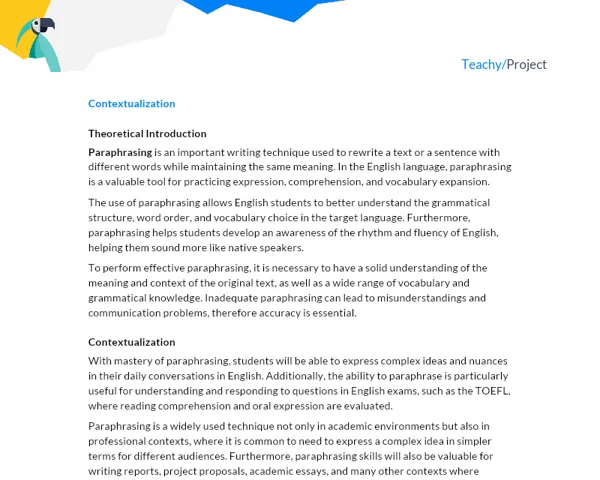Contextualization
Introduction
English is a rich and complex language, with a vast array of linguistic resources that allow us to express a multitude of ideas and concepts. One of these resources is the "Simple Future" tense, which we use to talk about plans, predictions, possibilities, and probabilities concerning the future.
The "Simple Future" tense is composed of the subject, followed by the auxiliary verb "will" and the main verb in its base form. For example, the sentence "I will go to the park" is a statement of future intention. We can also use the auxiliary "will" in questions, such as "Will you come to the party?"
It is important to remember that, although the "Simple Future" is a common verb tense, it is not the only one we use to talk about the future in English. Other verb tenses, such as the Present Continuous and the Future with "going to," are also used to express ideas about the future, each with its own particularities.
Contextualization
Why is it important to learn about the "Simple Future"? Because it is an essential tool for communicating about our plans and expectations. Whether it's telling a friend about our planned vacations, predicting the outcome of a game, or discussing the possible consequences of a decision, the "Simple Future" allows us to express these ideas clearly and precisely.
Moreover, the ability to talk about the future is crucial in any work or study context. Whether it's discussing future goals in a work meeting, writing a report predicting future trends, or talking with colleagues about project plans, the proper use of the "Simple Future" is an essential skill.
Atividade Prática
Activity Title
"Design Your Future with the Simple Future"
Project Objective
Architect and present a life project for the next 10 years, using the simple future tense to outline plans, predictions, possibilities, and probabilities.
Detailed Project Description
Students will be divided into groups of 3 to 5 members. Each group will have the task of creating a life script for one of the group members, projecting the next 10 years in detail. The script should cover different aspects of life, including education, career, family, hobbies, travel, etc. Throughout the script, students must use the "Simple Future" tense to express plans, predictions, possibilities, and probabilities.
Required Materials
- Notebook or paper for drafting
- Computer with Internet access for research
- Presentation software (PowerPoint, Google Slides, etc.)
Detailed Step-by-Step
-
Divide students into groups of 3 to 5 members.
-
Each group chooses a member for whom a life script will be created.
-
Groups should research different aspects of life (education, career, family, hobbies, travel, etc.) and project the next 10 years of the chosen member's life. Throughout the script, students must use the "Simple Future" tense to express plans, predictions, possibilities, and probabilities.
-
Groups should create a visual presentation of the life script using presentation software. The presentation should include English text using the "Simple Future," as well as images, graphics, and other visual elements to make the presentation engaging and informative.
-
After completing the life script and presentation, each group should prepare an oral presentation for the class. During the presentation, students should explain the life script, using the "Simple Future" to talk about the plans and predictions included in the script.
-
The deadline for project completion is one week.
Project Deliverables
-
Visual Presentation: Each group must submit a visual presentation of the life script. The presentation should be comprehensive, informative, visually appealing, and should use the "Simple Future" with accuracy and effectiveness.
-
Oral Presentation: Each group must present the life script to the class. During the presentation, students must demonstrate their understanding of the "Simple Future" and their ability to use it to talk about plans and predictions clearly and effectively.
-
Written Report: Each group must prepare a written report of the project. The report should include:
-
Introduction: Provide context on the topic, its relevance and real-world application, as well as the objective of this project.
-
Development: Explain the theory behind the Simple Future, detail the activity, indicate the methodology used, and finally present and discuss the results obtained.
-
Conclusion: Conclude the work by summarizing its main points, highlighting the learnings obtained, and drawing conclusions about the project.
-
Bibliography: Indicate the sources used to develop the project such as books, web pages, videos, etc.
-

